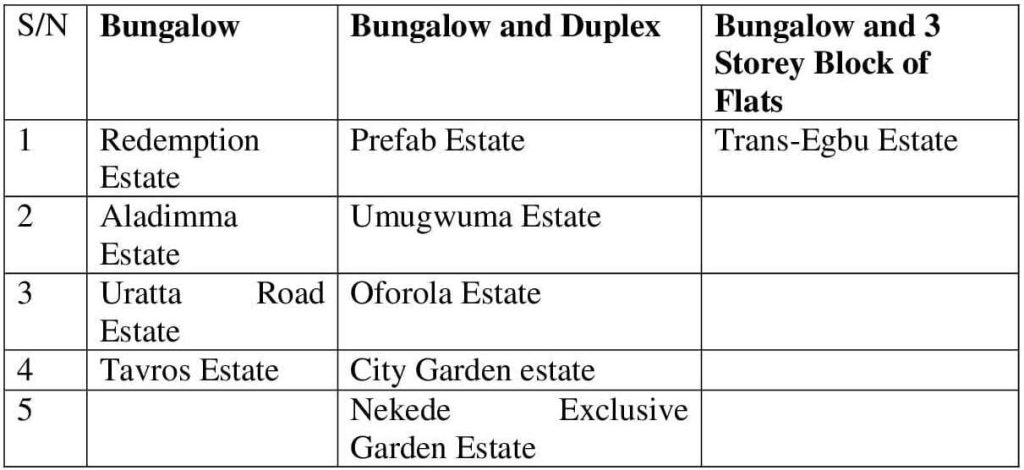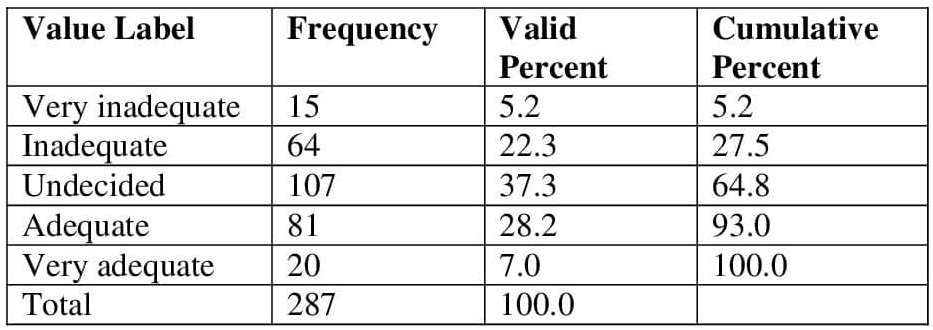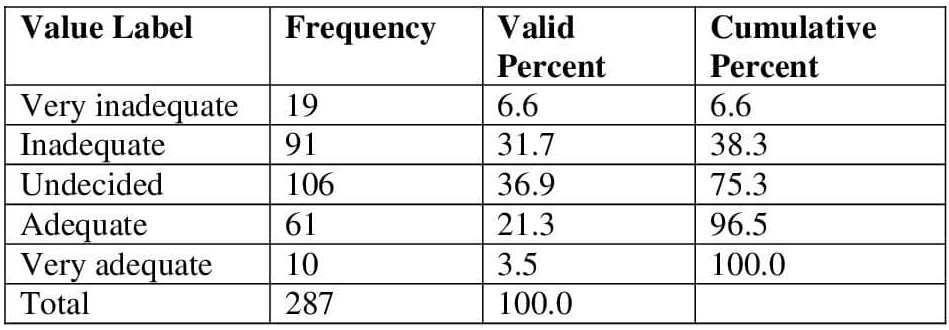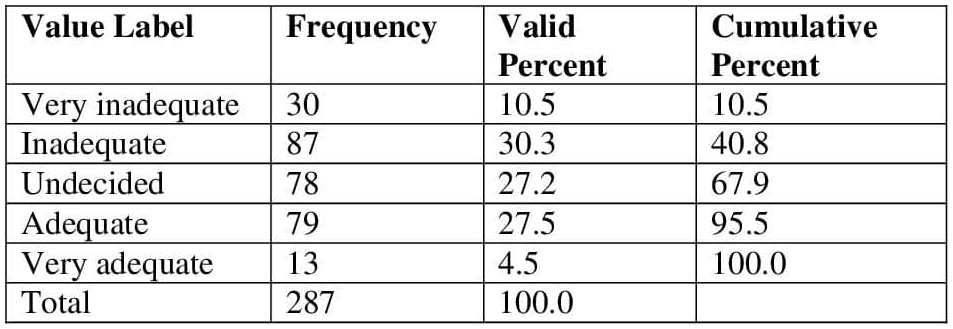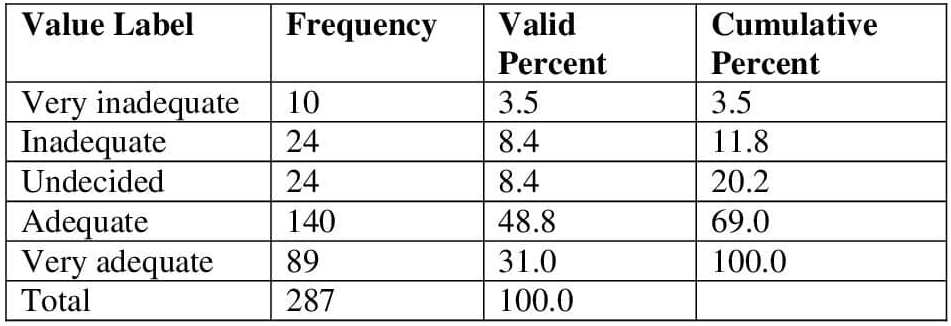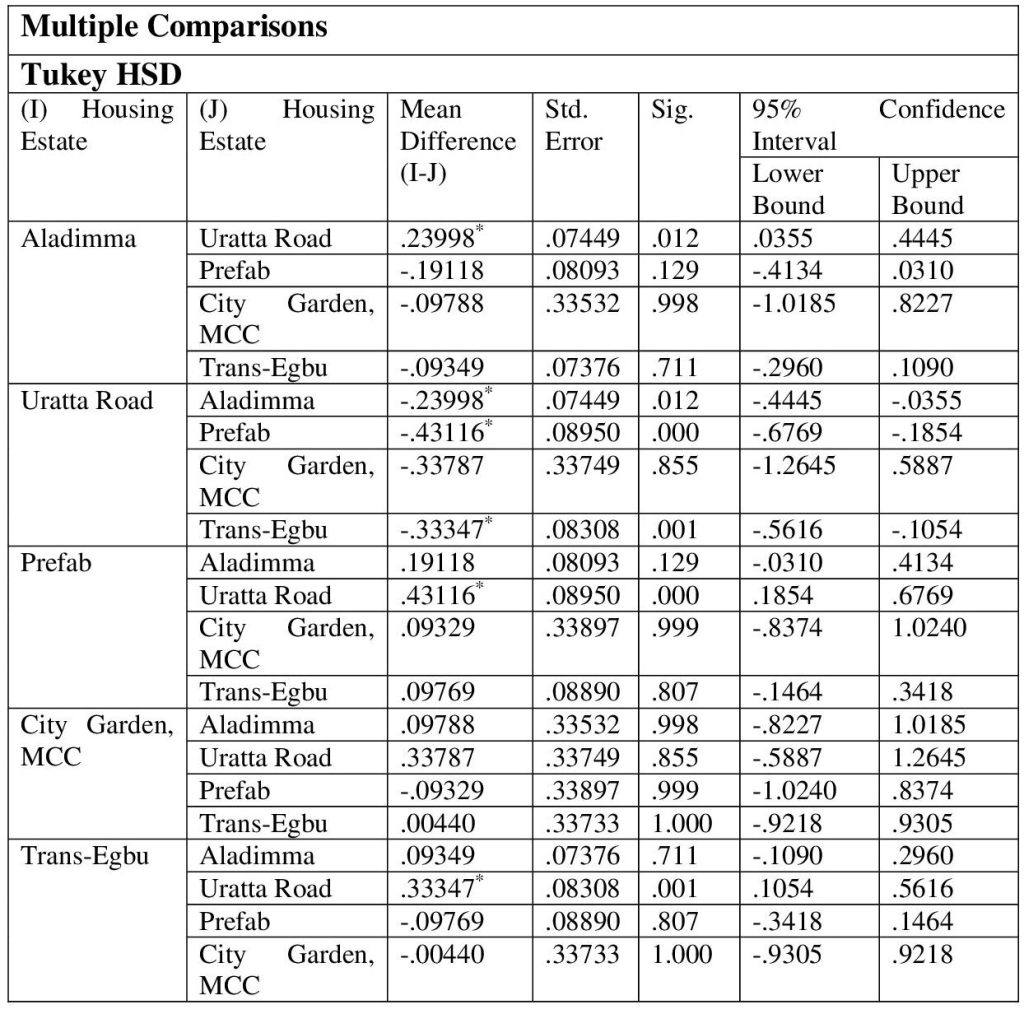
Journal of Medicine, Engineering, Environmental and Physical Sciences (JOMEEPS), Vol. 2, No. 1, March 2024. https://klamidas.com/jomeeps-v2n1-2024-03/ |
||||||||||||||||||||
|
Investigation of Differences in Housing Quality in Imo State Housing Corporation (IMSHC) Estates, Owerri, Nigeria Nnanyere N. Chukwu, Basil O. Agoha & Chukwunonso O. Umeora
ABSTRACT Rapidly increasing urbanisation rate has created a huge demand for urban housing in major Nigerian cities, including Owerri, the Imo State capital. From 2006 to 2016, Owerri has experienced an average population growth rate of 4.04% (United Nations, 2022). This, among other factors, has affected the housing quality in some public housing estates in Owerri Capital Territory. Due to the different conditions of the buildings, many of which are deteriorating, and lack of adequate maintenance, some of the estates have degenerated in quality and value. A pilot survey of some IMSHC Estates in Owerri has revealed that there is a preponderance of structurally unsound buildings in many of them. This has notable implications for the health, lifestyle and overall wellbeing of the residents. In view of these, this study was undertaken to assess the housing conditions in Imo State Housing Corporation (IMSHC) estates in Owerri capital territory with the aim of providing guidelines for improving housing quality in the study area. Based on empirical data, the study provides valuable feedback for improved housing development for public housing estates. The research has statistically proven that there is a significant difference in housing quality between the various estates of Imo State Housing Corporation (IMSHC). A number of recommendations are made by the study, most of which are aimed at urging the IMSHC to put in place the necessary machinery for timely maintenance and proper running of the estates. Keywords: housing quality, Imo State Housing Corporation, estates, Owerri
INTRODUCTION Developing countries (such as Nigeria) are faced with high rates of urbanisation that are not complemented by sufficient increase in the rate of economic development (Bello & Egresi, 2017). Agboola and Ayanlade (2016) stated that the urban population increased in Nigeria from 19.2% in 1963 to 42% in 1991 and 47.8% in 2015. This fast urbanisation rate created a huge demand for urban housing which could not be met by the government and the organized formal sector in major Nigerian cities. Consequently, between 20% and 35% of urban housing in Nigerian cities is either dilapidated or in need of major repairs because of poor housing conditions in the various housing schemes (Muhammad & Bichi, 2014). Owerri, the capital of Imo State, is not left out in urbanisation and population growth. From 2006 to 2016, Owerri has experienced an average population growth rate of 4.04% (United Nations, 2022). The consequences of the population growth are evident in the urban housing crisis which has affected the housing conditions as the supply of housing stock manifestly lags behind the needs of the populace. This was corroborated by Aotearoa (2009) as cited in Umeora (2020a). Housing quality has been defined as the totality of the state of the physical, environmental and satisfaction level to the occupant of a particular dwelling unit measured against some variables of liveability in a specific time (Muhammad, Bello, Ishaq, Bello & Adamu, 2021). Housing quality is a comprehensive concept that determines whether housing is sufficient to meet recognised housing standards and specific household needs. Studies (Awe and Afolabi, 2017; Mbazor, 2018; Muhammad, Kasim, Martin, Mohammed, and Adamu, 2015) undertaken in different Nigeria cities revealed poor housing quality as deplorable conditions in building elements such as roofs, doors, windows, floors, ceilings, and walls; lack of potable water, toilet and bathing facility, solid waste disposal facility and electricity supply; and generally poor infrastructure and an increasing shortage of urban services and infrastructure. All these make the buildings to be in a bad state, and unsuitable for human habitation. The housing quality in some public housing estates in Owerri Capital Territory seems to be deteriorating due to different conditions of the buildings, and the environment. Some of these Estates have degenerated over the years in quality and value. The appalling state of repair of buildings and infrastructure was observed in a pilot survey of some IMSHC Estates in Owerri, Nigeria. This revealed a preponderance of structurally unsound buildings. Such houses affect the way the residents spend their income and leisure time; and they also affect their health, attitudes, and social relations. In view of the above, this study seeks to assess the housing conditions in Imo Housing Corporation estates in Owerri capital territory with the aim of providing guidelines for improving housing quality in the study area. Aigbavboa and Thwala (2013) have noted that there is a need to carry out studies on housing with residents in order to provide relevant post-occupancy feedback towards the development of housing that meets adequate quality. The study would provide a feedback based on empirical data for improved housing development for public housing estates. This study was part of a wider research that sought to examine the effect of housing conditions on housing quality in Imo Housing Corporation estates in Owerri capital territory to provide guidelines for improving housing quality in the study area. The specific objective of this study was to investigate the physical conditions of building units and their effect on housing quality in Imo State Housing Corporation (IMSHC) estates in Owerri Capital Territory, Nigeria. Study Area The study was carried out in Owerri Capital Territory. Owerri is the capital of Imo State, Nigeria. It is in South-East geopolitical region of Nigeria. It was created by the military administration of General Murtala Ramat Muhammed on February 3rd, 1976. Owerri Capital Territory is located between latitudes 05˚25’ and 05˚32’ North and longitudes 06˚57’ and 07˚07’. Rainfall is the greatest climatic variable with an annual total mean of 2190mm (Chukwuocha, Ngah, & Chukwuocha, 2017). Owerri Capital Territory cut across some local governments in Imo State which include: Owerri Municipal, Owerri West, Owerri North and parts of Mbaitoli, Aboh Mbaise, Ngor Okpala, Ohaji/Egbema and Ikeduru Local Government Areas. Figure 1 is the Map of Nigeria showing Imo State and the study area.
Figure 1: Map of Nigeria showing Imo State and the study area (Owerri Capital Territory) Source: Owerri Capital Development Authority (updated, 2009) Owerri Capital Territory is approximately 100 square kilometres in area. It is the capital of the Imo State of Nigeria, set in the heart of Igbo land. The existence of some tertiary institutions, which include the Federal University of Technology Owerri, Federal Polytechnic Nekede Owerri, Alvan Ikoku Federal College of Education Owerri, Federal College of Land Resources Owerri, Imo State University Owerri, Imo State University of Environmental Studies Umuagwo Owerri, as well as the existence of many hotels, has contributed to increased housing demand in Owerri. Imo State Housing Corporation has developed fourteen (14) housing estates in Owerri. Also, there has been a noticeable migration of people from various parts of Nigeria to Owerri in search of job opportunities and better means of livelihood. All these have led to continuous increase in the population of Owerri. There is a resultant increase in pressure on limited facilities, and this is manifested in the growth of squatter settlements, overcrowded habitation, breakdown of waste disposal arrangements, inadequate water and power supply as well as generally poor environmental sanitation. The government of Imo State, in its bid to reduce the level of housing shortage and provide housing to the teeming population of Owerri, established the Imo State Housing Corporation (IMSHC). From 1976 to 2016, the IMSHC developed fourteen (14) housing estates in Owerri. LITERATURE REVIEW The definition of housing quality embraces many factors that include the physical condition of the building and other facilities and services that make living in a particular area conducive (Lanrewaju, 2012). According to Yakubu and Etemini (2015), the quality of housing is a complex concept with broad social and economic meaning. It accounts for both quantitative and qualitative dimensions of residential units, their immediate surroundings, and the needs of the occupants. Moreover, the concept of the quality of housing is relative as it relates to local standards and conditions. What is reasonable quality in one context may be considered poor quality in another context and vice versa. The quantitative parameters of housing quality refer primarily to objective structural, material, social and economic constituents of housing products or outcomes that can be measured to gauge the performance of the housing sector. The factors include considerations such as price, quantity, tenancy tenure, economic impacts, environmental impacts, and structural norms of housing standards. The qualitative dimension is much more subjective and difficult to measure (Garg, Dhagat, & Shrivastava, 2014). It represents the perceived meanings and values of factors such as the ‘comfort’ or ‘quality of life’ that are afforded by different dwelling types, lifestyles, and the preferences and expectations of the inhabitants (Yakubu & Etemini, 2015). Housing quality is often evaluated in terms of the quality of design, building materials, the standard of construction, and the provision and performance of public amenities. However, the satisfaction of the user population with housing and its environment is an important determinant of housing quality (Olotuah & Taiwo, 2015). Housing quality studies can be justified because, through their assessment of the quality and quantity of the physical infrastructure as well as its social dimensions, they serve as indispensable instruments for measuring the standard of living, level of technological advancement, culture, and civilization of a given group or community (Morenikeji, et al., 2017). The problem of deficiency in housing quality in Nigeria is common both in urban and rural areas; it is, however, more severe in urban areas as most people live in houses that are poor, in terms of quality, and are located in unsatisfactory physical environments (Morenikeji, et al., 2017). According to Kurian and Thampuran (2011), the definition of housing quality varies widely, as it is based on people’s perspectives. This notwithstanding, a good habitat requires enough space, separate rooms for different purposes and enough privacy; it requires good climatic conditions, such as enough sunlight and free passing of air, and availability of water, good drainage as well as sanitary facilities. Furthermore, housing quality is not just about the aesthetics of the building; rather, it is a holistic fitness of the dwelling unit – from the design, the functionality of spaces in the building, the presence and status of services in the building, the level of satisfaction of the occupant, the immediate environment, the neighbourhood, its state of infrastructure to the housing standards. Housing quality showcases the social and economic viability of the physical environment or geographical settlement. It is a key determinant of an individual’s or a community’s well-being. METHODOLOGY The research design for this study was survey design. This was achieved through the use of a questionnaire to collect data from respondents in the study area. The research population was the completed IMSHC estates within Owerri Capital Territory, built and inhabited between 1976 and 2016, when the last housing estate was completed. Stratified sampling of the estates based on building type was adopted as the sampling method for this study. In the first stage, the list of the 14 estates completed and occupied in the study area was generated as shown on Table 1. Table 1: List of Imo State Housing Corporation Estates in Owerri Capital Territory
In the second stage, the categorisation of the estates based on building type was done. The categorisation of the estates is bungalows, bungalows and duplexes combined, bungalows and 3-storey block of flats combined. Table 2 describes the categorisation based on the criterion stated. Table 2: List of Imo State housing corporation estates in Owerri categorised by house type in the estates
Source: Fieldwork, 2023 Following the categorization, random sampling by balloting was carried out and the following were picked to represent the various building types: i. Bungalows: Aladimma Estate and Uratta Road Housing Estate ii. Bungalows and Duplex combined: Prefab estate and City Garden Estate iii. Bungalow and 3 Storey Block of Flats: Trans-Egbu Sampling size was derived using Cochran formula for finite population: from Kothari (2004)
Where: n = size of sample for finite population N = research population = 1484housing units σp = standard deviation of population assumed = 0.5 e = significance level (precision/acceptable error) chosen = 0.05 Z = standard variate at a given confidence level = 1.96 for a confidence level of 95% Sample size of 305 respondents was derived and distributed to the estates in ratio of their contribution as shown in Table 3. Table 3: Respondents Population in Sampled Estates
Source: Fieldwork, 2023 A systematic random sampling was used in the selection of housing units in each street of the housing estates. After the first house, every fourth house was surveyed. In each house, in case of a multi-family unit, one household would be administered with the questionnaire. RESULTS AND DISCUSSION Descriptive summary measures and frequency distribution for each of the variables studied were calculated. Analysis of Variance test was used to test significant difference between the estates selected from using Statistical Package for Social Sciences. Analysis of Aggregated Data of Protection against insects and pests in the Estate The aggregated data analysis of this variable indicated that 28.2% of the respondents indicated that the building had adequate protection against insects and pests while 22.3% indicated that they had no adequate protection against insects and pests as shown in Table 4. This protection was essential towards promoting the well-being of the residents. Table 4: Aggregated Data on Protection against insects and pests in the Estate
Source: Fieldwork, 2023 Analysis of aggregated data of good toilet and bathroom facilities in the estate The study conducted shows that 37.6% of the respondents reported that the toilet and bathroom facilities were adequate while 31.0% of the respondents reported that they are inadequate and 3.5% reported as very inadequate. Table 5 shows this. Table 5: Aggregated Data on Good toilet and bathroom facilities in the Estate
Source: Fieldwork, 2023 Aggregated Data Analysis of Waste Disposal Facilities in the Estate From the analysis, there was a high level of inadequate waste disposal facilities in the estate which was reported by 31.7% of the respondents while 21.3% of the respondents reported the level of adequacy as just adequate. Table 6 displays the result. Table 6: Aggregated data on waste disposal facilities in the estate
Source: Fieldwork, 2023 Analysis of Aggregated Data of External Lighting in the Estate The analysis showed that inadequate external lighting has the highest response 30.3% as experienced by the residents in the estate. 27.5% of the respondents indicated that they experienced adequate external lighting features for use at nights, see Table 7. Table 7: Aggregated Data on External lighting in the estate
Source: Fieldwork, 2023 Analysis of Aggregated Data on the Adequacy of Road Network within the Estate From the results gathered, only 11.9% of respondents pointed out that the road network within the estate was inadequate as shown in Table 8. The majority of the respondents noted that the road network within the estate was very adequate. Table 8: Aggregated data on adequacy of road network within the estate
Source: Fieldwork, 2023 Analysis of Aggregated Data of Dampness in the Building The data analysed showed that most of the respondents stated that they did not experience dampness in their building while 48.1% of the respondents indicated that the building experienced dampness, see Table 9. This affected the well-being of the residents. Table 9: Aggregated data on dampness in the building
Source: Fieldwork, 2023 Test of Hypotheses Differences in housing quality between the housing estates in the study area The investigation of this difference in housing quality in the estates was done. Table 10 illustrates the one-way ANOVA test results for this variable and the results indicate a significance probability point of 0.000. This implies that there is a significant difference between the estates in housing quality. The null hypothesis is therefore rejected and alternate accepted. This is that ‘There is significant difference in housing quality in IMSHC estates in Owerri Capital territory’. Table 10: One-way ANOVA analysis test results showing the difference between groups in housing quality in the estates
Source: Fieldwork, 2023 The results of the difference in means in Table 4.127 showed that Aladimma had a slightly lower value in housing quality than the Uratta Road estate (0.23), although this was statistically significant. Prefab estate likewise had a slightly lower value of housing quality than Aladimma (.191). City Garden estate also had a lower value of housing quality than Aladimma (.097), and the Trans-Egbu estate also had a lower value of housing quality than Aladimma (.093). The Tukey HSD post hoc test was done to establish the level of significance of the difference between the estates, and this is presented in Table 11. Table 11: Tukey HSD Post Hoc analysis test results showing the nature of difference in housing quality in the estates
Source: Fieldwork, 2023 The results of a one-way ANOVA analysis done at a 95% confidence level led to the rejection of the null hypothesis and the choice of the alternate. It was statistically proven that there is a significant difference between the estates in housing quality. The results were further exposed to a Tukey HSD post hoc test to determine the level of significance within the groups. The outcome showed that ‘Uratta estates’ had a significant difference in housing quality with ‘Prefab’ estate. It was found also that there was a significant difference between the Aladimma estate and the Uratta estate in housing estates. Also, between the Uratta and Trans-egbu estates, where there is a significant difference. The implications were namely: i. Aladimma estate was inferior to other estates in the enumerated category in housing quality. ii. Prefab estate was superior to other estates in housing quality. iii. There seemed, therefore, to be an additional regular effort by Prefab estate towards maintaining buildings and facilities to attain housing quality as the variable investigated. CONCLUSION AND RECOMMENDATIONS This research has statistically proven that there is a significant difference in housing quality between the IMSHC estates. Equally, the results of the Post hoc test showed that the Prefab estate had better housing quality, followed by the Aladimma estate, City Garden estate, Trans-Egbu estate and Uratta estate, in that order. Therefore, IMSHC should put machinery in place that would be responsible for running the estates to ensure that facilities within the estates are maintained. They should also track performance by regular visits and interactions with the residents. Some form of encouragement or incentives might be provided for the staff of IMSHC who ensure that estates assigned to them remain in good condition. The information gained through this feedback system would then be used to guide them towards achieving an effective management system. To guide them towards ensuring adequate housing quality, the IMSHC should also make available manuals for maintenance operations to residents. IMSHC should put in place proper ways of wastewater evacuation and refuse disposal, and adequate waste disposal facilities, to maintain adequate housing quality. This will certainly improve the existing housing quality in the IMSHC estates. There is the need to buttress cleaning of drainages within the estates to prevent flooding and to improve the level of housing quality. Drains within the estate should be strictly meant for surface water runoff and not for wastewater evacuation. The drains should be of good slope and capacity to ensure smooth water runoff, accessibility, cleaning and easy maintenance. This ensures that wastewater from the buildings is emptied into soak-away pits and not allowed to flow into open drains. The proper mode of refuse disposal should also be encouraged to limit refuse dumping as noted in this study. All these, when done, would promote quality within the neighbourhood. Attention should be paid to the promptness with which repairs are carried out and the communication channel between residents and the IMSHC. This ultimately would lead to an improved level of housing quality.
REFERENCES Agboola A. M., Ayanlade A. (2016), Sea level rise and its potential impacts on coastal urban area: A case of Eti-Osa, Nigeria. Analele Universitatii din Oradea, Seria Geografie 27(2): 188-200. Aigbavboa C.O & Thwala W.D. (2013). Housing Satisfaction in Subsidized Housing Schemes: A case study of Johannesburg, Gauteng Province, South Africa. J Hum Ecol, 42(3), 245-257. Aotearoa, T. (2009). Measuring Housing Quality: potential ways to improve data collection and housing quality in New Zealand. Review of Housing Statistics Report. Awe, F.C., & Afolabi, F. I. (2017). Assessment of Housing Quality in Urban Core of Ado-Ekiti, Nigeria. Civil and Environmental Research, 9(7), 37–43. Bello, A. & Egresi, I. (2017). Housing conditions in Kano, Nigeria: a qualitative assessment of adequacy. Analele Universităţii din Oradea, Seria Geografie, 2, 205-229 Chukwuocha, N. A., Ngah, S. A., & Chukwuocha, A. C. (2017). Vulnerability Studies of Sensitive Watershed Areas of Owerri South East Nigeria Using Digital Elevation Models. Journal of Geoscience and Environment Protection, 1-3. Garg, Y., Dhagat, N., & Shrivastava, B. (2014). Housing quality and customer satisfaction with reference to delivery methods. Global Journal of Engineering, Design & Technology, 1. Kothari, C. R. (2004). Research Methodology: Methods and Techniques (2nd ed.). New Delhi: New Age International Ltd. Kurian, S. M., & Thampuran, A. (2011). Assessment of Housing Quality. Institute of Town Planners, India Journal, 74-77. Lanrewaju, F. A. (2012). Urbanization, housing quality and environmental degeneration in Nigeria. Journal of Geography and Regional Planning, 423-425. Morenikeji, W., Umaru, E., Pai, H., Jiya, S., Idowu, O., & Adeleye, B. M. (2017). Spatial Analysis of Housing Quality in Nigeria. International Journal of Sustainable Built Environment, 1-2. Muhammad, M., & Bichi, A. M. (2014). Contraints and Challenges on Housing Provision in Kano City, Nigeria. International Journal of Advancements in Research & Technology, Volume 3, 4-23. Muhammad, M.S., Bello, H.T., Ishaq, M.M., Bello, M.U, & Adamu, D (2021). Factors Determining Housing Quality in Selected Neighbourhoods of the Bauchi Metropolis, Nigeria. Traektoriâ Nauki = Path of Science. 7(12) 2007-2014 Muhammad, M. S., Kasim, R., Martin, D., Mohammed, M. I., & Adamu, D. (2015). Housing Quality in Segregated Residential Neighbourhoods in Bauchi Metropolis. International Journal of Scientific and Research Publications, 5(11), .432–440. Olotuah, A. O. & Taiwo, A. A. (2015). Housing Strategies and Quality of Housing in Nigeria: What lessons from Wales. Developing Country Studies, 1-7. Umeora, C.O. (2020). Examination of state of repair of buildings in private housing estates in Enugu metropolis, Enugu state Nigeria. Journal of Environmental Sciences and Resources Management, 12(1), 52-66. United Nations. (2022). World Population Prospects 2022. New York: United Nations Department of Economic and Social Affairs/Population Division. Yakubu, A. U., & Etemini, S. E. (2015). Analysis of Housing Quality in the Peripheral Area of Lafia, Town. International Journal of Geography and Regional Planning Research, 10-16. |
||||||||||||||||||||
|
||||||||||||||||||||


